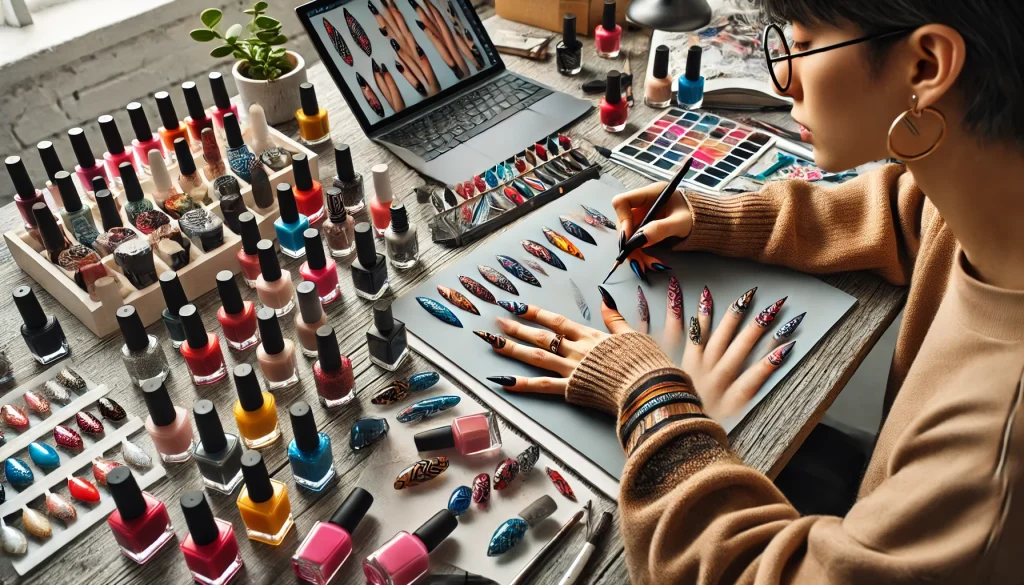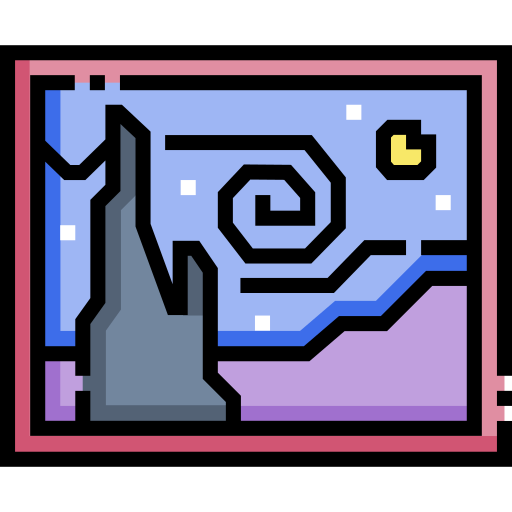In the ever-evolving world of beauty, nail art stands as a bold form of self-expression. Nail Art Experimentation encourages you to break free from conventional designs and push the creative boundaries of your manicure. Whether you’re a seasoned artist or a beginner eager to explore new techniques, this guide will inspire you to take risks, try innovative methods, and transform your nails into a true work of art.

Index
The Essence of Nail Art Experimentation
Nail Art Experimentation is about embracing creativity and exploring uncharted territories in nail design. It involves stepping outside your comfort zone, mixing unexpected elements, and discovering unique patterns that speak to your personal style. Experimenting with nail art not only enhances your technical skills but also opens up new avenues for self-expression.
Why Embrace Nail Art Experimentation?
- Creativity Unleashed: By experimenting with different colors, textures, and patterns, you can discover styles that are uniquely yours. This process fosters creativity and innovation in every design.
- Skill Development: Pushing creative boundaries improves your technical abilities and helps you master both basic and advanced nail art techniques.
- Trendsetting Potential: Experimentation often leads to the discovery of new trends. Your daring designs might set the stage for the next big trend in nail art.
- Personal Expression: Your nails become a canvas to express your individuality, mood, and artistic vision. Each experimental design tells a story about who you are.
Essential Tools for Nail Art Experimentation
Successful Nail Art Experimentation starts with having the right tools. Investing in a well-equipped nail kit will not only streamline your creative process but also elevate your designs to professional standards.
1. Precision Tools
- Fine Brushes and Dotting Tools: Essential for creating delicate lines, intricate patterns, and small details that define high-quality nail art.
- Striping Tapes and Stencils: These accessories are invaluable for creating clean, geometric patterns and helping you experiment with structured designs.
- Nail Art Pens: Perfect for freehand drawing, nail art pens allow you to experiment with various patterns and motifs with precision.
2. Decorative Embellishments
- Rhinestones, Studs, and 3D Elements: Add dimension and texture to your designs. These embellishments can be strategically placed to accentuate and enhance your experimental nail art.
- Glitter, Metallic Foils, and Shimmer Powders: Experiment with different finishes to add sparkle and vibrancy. Mixing matte and glossy textures can produce stunning visual contrasts.
- Decals and Stickers: Ideal for those moments when you want to quickly incorporate intricate designs without relying solely on freehand skills.
3. Quality Nail Polishes and Base/Top Coats
- Diverse Color Palette: A wide range of colors is essential for Nail Art Experimentation. Explore both bold and subtle shades, and mix various finishes like matte, glossy, and metallic.
- High-Quality Base and Top Coats: Protect your natural nails and ensure longevity of your experimental designs. A durable top coat also enhances shine and prevents chipping.
4. Advanced Tools
- LED and UV Curing Lamps: If you’re working with gel polishes, these curing lamps ensure your designs set quickly and evenly.
- Digital Nail Art Tools: Emerging technologies like nail art printers and design apps can help you visualize and execute complex designs with ease.
Techniques to Push Creative Boundaries
When it comes to Nail Art Experimentation, the techniques you employ can make all the difference. Experimenting with various methods will allow you to discover innovative designs and refine your skills.
1. Freehand Drawing
- Unleash Your Creativity: Freehand drawing lets you create designs that are entirely unique. Whether it’s abstract art, delicate florals, or intricate doodles, freehand techniques require practice but yield deeply personal results.
- Layering Colors: Experiment with layering different hues to create depth and texture. Combining complementary or contrasting colors can result in striking visual effects.
2. Geometric Patterns and Negative Space
- Structured Designs: Use striping tape and stencils to create geometric patterns that are both modern and sophisticated. These designs are perfect for those looking to balance experimental elements with clean, defined lines.
- Embracing Negative Space: Allowing parts of the nail to remain unpolished can create an eye-catching contrast and add a modern twist to your design. Negative space designs are all about balance and visual impact.
3. Textured and 3D Nail Art
- Adding Dimension: Incorporate textured gels and 3D embellishments like rhinestones, studs, or tiny decals to create tactile designs that stand out.
- Sculptural Techniques: Experiment with layering different elements to build a multi-dimensional look. This approach can transform a flat design into a dynamic, artful creation.
4. Water Marbling and Gradient Effects
- Marbling Techniques: Create mesmerizing, abstract patterns by dropping different colors of polish into water and swirling them together. Dip your nails into the marbled water to transfer the design onto your nail surface.
- Ombre and Gradient Effects: Blend two or more colors seamlessly to create a smooth gradient. Use a makeup sponge or a brush to achieve a gradual transition, adding a subtle yet sophisticated element to your nail art.
5. Digital and Innovative Techniques
- Nail Art Apps and Printers: Leverage digital tools to experiment with complex designs. These technologies can help you plan, customize, and execute intricate patterns that might be challenging to achieve freehand.
- Smart Tools: Incorporate LED curing lamps and temperature-controlled brushes to ensure precision and consistency in your designs.
Inspiration for Nail Art Experimentation
Finding inspiration is crucial when you’re pushing the creative boundaries of Nail Art Experimentation. Here are some sources to fuel your imagination:
1. Social Media and Online Platforms
- Instagram and Pinterest: Follow leading nail artists and hashtags related to nail art to discover the latest trends and creative ideas.
- YouTube Tutorials: Video tutorials offer step-by-step guidance on advanced techniques, helping you master new methods and refine your skills.
2. Fashion and Art
- Runway Trends: Fashion shows often set the stage for innovative nail art. Look for inspiration in the colors, textures, and patterns showcased on the runway.
- Modern Art and Design: Contemporary art, abstract painting, and graphic design can all influence your nail art. Experiment with translating these artistic concepts onto your nails.
3. Nature and Seasonal Changes
- Natural Patterns: Draw inspiration from the natural world—leaves, flowers, and even the texture of stones can inform your designs.
- Seasonal Palettes: Adapt your color choices and patterns to reflect the changing seasons. Vibrant hues for summer, warm earth tones for fall, icy shades for winter, and soft pastels for spring can all be integrated into your experimental designs.
Practical Steps for Nail Art Experimentation
To begin your journey in Nail Art Experimentation, follow these practical steps:
Step 1: Preparation and Planning
- Set Up Your Workspace: Ensure your area is well-lit and organized. Having all your tools within reach will make the process smoother.
- Plan Your Design: Sketch your ideas on paper or use a digital app to visualize your design. Planning helps you understand the steps required and reduces the likelihood of errors.
- Prepare Your Nails: Clean, shape, and apply a base coat to create a smooth canvas for your art. Healthy nails are essential for a successful outcome.
Step 2: Experiment with Different Techniques
- Try Small Projects: Start with a single nail or a small section of your nail to test a new technique. This minimizes the risk and allows you to refine your approach.
- Mix and Match: Don’t hesitate to combine different techniques—such as geometric patterns with freehand elements or marbling with 3D accents. The beauty of Nail Art Experimentation lies in the fusion of various styles.
- Document Your Process: Keep a journal or take photos of your designs. Tracking your progress will help you identify what works best and inspire future projects.
Step 3: Evaluate and Refine
- Assess Your Design: Once your nail art is complete, take a step back and evaluate your work. Look for areas that can be improved or techniques that need further practice.
- Seek Feedback: Share your designs with friends, online communities, or fellow nail artists. Constructive feedback can provide new perspectives and ideas.
- Refine Your Skills: Use the insights gained from each project to improve your technique. Nail art is a continuous learning process, and each experiment builds your confidence and expertise.
Overcoming Challenges in Nail Art Experimentation
While Nail Art Experimentation can be exhilarating, it may also present challenges. Here are some common obstacles and ways to overcome them:
1. Tool Control and Precision
- Practice Makes Perfect: If fine details are challenging, practice on a nail art practice sheet. Consistent practice will improve your hand steadiness and control.
- Use Guides: Employ stencils, striping tape, or dotting tools to help maintain precision in your designs. These accessories can be invaluable for achieving clean, professional lines.
2. Color Bleeding and Smudging
- Thin Layers: Apply polish in thin, even layers to minimize the risk of smudging. Allow each layer to dry completely before applying the next.
- Proper Drying: Use a quick-dry top coat to help set your design and prevent color bleeding. Avoid excessive exposure to water or chemicals that can weaken the polish.
3. Maintaining Consistency
- Standardize Your Techniques: Develop a routine or sequence for your design process to ensure consistency across your nails.
- Quality Products: Invest in high-quality nail polishes and accessories. Superior products perform better and are less likely to result in uneven application.
Inspiration Through Continuous Experimentation
The journey of Nail Art Experimentation is an ongoing adventure. Embrace the spirit of continuous learning and creativity by constantly seeking out new ideas and techniques. The more you experiment, the more you’ll refine your style, and the more unique your nail art will become.
- Challenge Yourself: Set personal challenges, like creating a new design each week or experimenting with a color you’ve never used before. These challenges can push your creativity further.
- Collaborate with Others: Share your work and collaborate with fellow nail artists. Joining online forums or local groups can provide fresh inspiration and valuable feedback.
- Stay Curious: Always be on the lookout for emerging trends, innovative tools, and novel techniques that can add a new dimension to your Nail Art Experimentation.
Conclusion
Nail Art Experimentation is more than just a hobby—it’s a form of artistic expression that allows you to push creative boundaries and develop a style that is uniquely yours. By embracing a spirit of innovation, investing in quality tools, and continuously challenging yourself, you can transform your nails into a dynamic canvas that tells your personal story.
From freehand drawing and geometric patterns to 3D embellishments and digital techniques, the possibilities are endless. Remember, every experiment is a learning opportunity, and even the most unexpected designs can lead to breakthroughs in your creative journey.
Embrace the adventure of Nail Art Experimentation, and let your nails become a vibrant expression of your imagination and individuality. For more expert tips, detailed tutorials, and endless creative inspiration, visit our website at eu.artereciclada.com.br.
